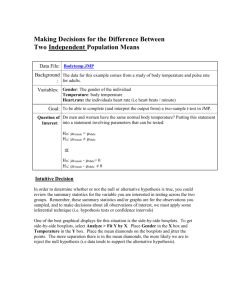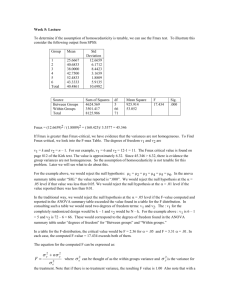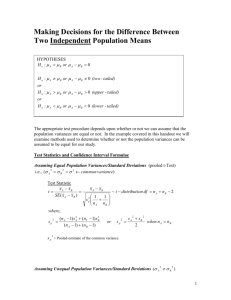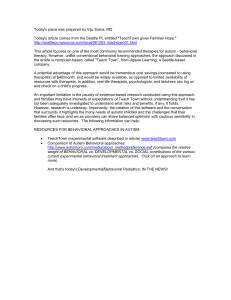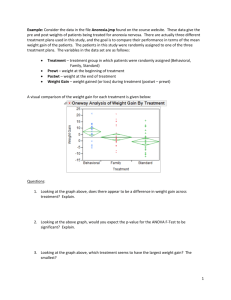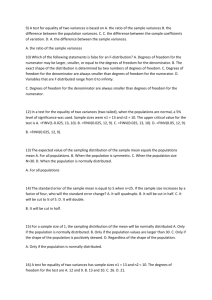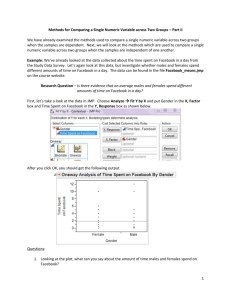Comparing Two or More Population Means Using Analysis of Variance
advertisement
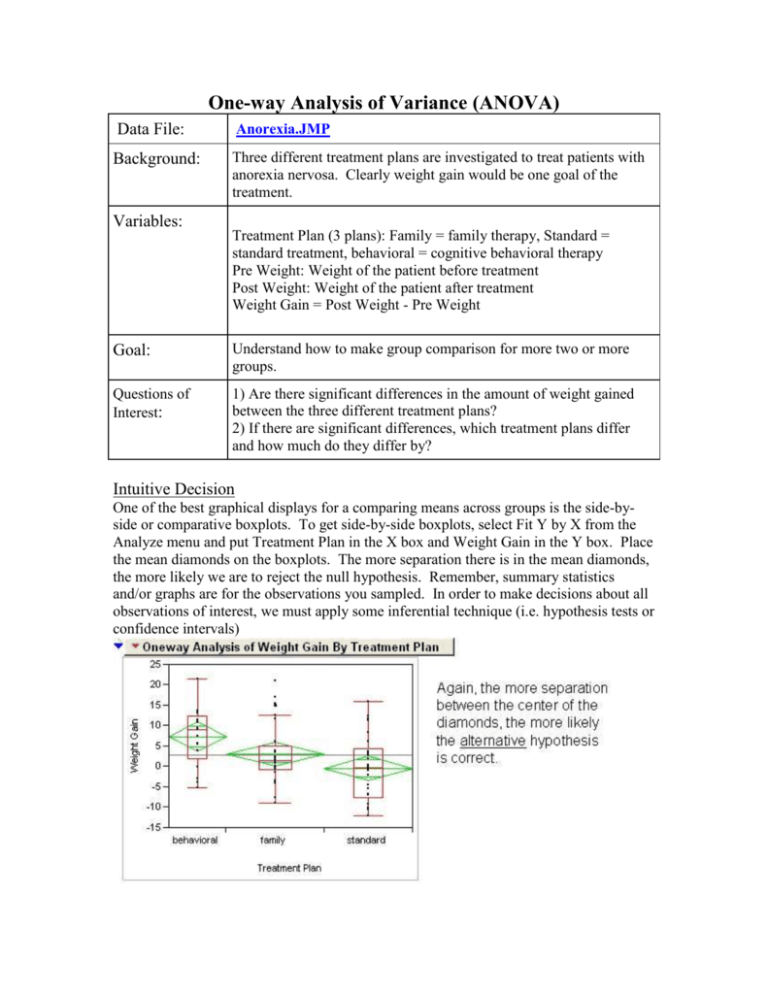
One-way Analysis of Variance (ANOVA) Data File: Anorexia.JMP Background: Three different treatment plans are investigated to treat patients with anorexia nervosa. Clearly weight gain would be one goal of the treatment. Variables: Treatment Plan (3 plans): Family = family therapy, Standard = standard treatment, behavioral = cognitive behavioral therapy Pre Weight: Weight of the patient before treatment Post Weight: Weight of the patient after treatment Weight Gain = Post Weight - Pre Weight Goal: Understand how to make group comparison for more two or more groups. Questions of Interest: 1) Are there significant differences in the amount of weight gained between the three different treatment plans? 2) If there are significant differences, which treatment plans differ and how much do they differ by? Intuitive Decision One of the best graphical displays for a comparing means across groups is the side-byside or comparative boxplots. To get side-by-side boxplots, select Fit Y by X from the Analyze menu and put Treatment Plan in the X box and Weight Gain in the Y box. Place the mean diamonds on the boxplots. The more separation there is in the mean diamonds, the more likely we are to reject the null hypothesis. Remember, summary statistics and/or graphs are for the observations you sampled. In order to make decisions about all observations of interest, we must apply some inferential technique (i.e. hypothesis tests or confidence intervals) Assumptions The groups must be independent of each other. The groups should have the same population variance. The observation from each group should be normally distributed. To check Assumption #3, select Oneway Analysis drop-down menu > Normal Quantile Plot > Plot Quantiles by Actual It is somewhat difficult to identify which groups are which for this example. The line furthest to the left corresponds to the boxplot which is closest to the bottom in the above plot (in this case, standard). The line in the middle corresponds to the boxplot in the middle (in this case, family), and the line furthest to the right corresponds to the highest boxplot. To test the equality of the population variances select Unequal Variances from the Analysis pull out menu below the plot. JMP gives four different p-values for testing whether or not the population variances are equal. In this example, there are three different treatment plans, so here we are testing Ho: Population VarianceGroup1 = Population VarianceGroup2 = Population VarianceGroup3 Ha: Population Variances are not all equal. Recall, that if any of the p-values are less than your pre-specified error rate, then the 2nd assumption is not satisfied. Here we can see that none of the p-values are less than an error rate of 5%, thus indicating we have no evidence against the equality of the variances. Performing the Overall Test to Compare the Population Means Question of Interest: Are there significant differences in the amount of weight gained between the three different treatment plans? Putting this in a testable form: Ho: Average Weight GainGroup1 = Average Weight GainGroup2 = Average Weight GainGroup3 Ha: Average Weight Gains are not all equal. Furthermore, if we let Average Weight Gain, then we are testing Ho: Group1 = Group2 = Group3 Ha: 's are not all equal. To determine whether or not the data supports the alternative hypothesis, select the Means,Anova/t-test option from drop-down menu. Several new boxes will appear below the graph, some of which we will not concern ourselves with at this point. What is the test statistic for this test? What is the p-value? What is your decision for the test? Write a conclusion for your findings. Note: If the tests for the population variances had indicated that the variances were unequal then we would want to use the p-value for the Welch’s Anova test for comparing the population means. Again, in this case, Welch's test agrees with the results obtained above. Determining which groups are statistically different Graphically comparing differences between groups: There are 3 different treatment plans, so we have to make 3*(3-1)/2 possible pair-wise comparisons. Decide whether or not statistical differences exist for each pair : 1. Behavioral - Family: 2. Behavioral - Standard: Family - Standard: Another table that can be used to determine which pairs of means differ To determine ranges for true differences via confidence intervals (this is better than the above yes/no type decisions that can be made) we need to look at the Ordered Differences section of the output in JMP As an example, interpret the 95% confidence interval for Behavioral - Family: (-1.25, 9.766) We estimate that anorexia patients receiving behavioral therapy have between a 1.25 lb. lower to 9.766 lb. larger weight gain on average when compared to patients being treated using family therapy. It is standard to quantify the difference between the means we find to be statistically different from one another. Here that would mean quantifying the difference between behavioral and standard therapies. Nonparametric alternative: The nonparametric alterative for the overall ANOVA test is Wilcoxon/Kruskal-Wallis Test. To perform this test, select Nonparmetric > Wilcoxon Test from the One-way Analysis drop-down menu. The p-value under Prob > ChiSq is the one that should be used in this case. When this procedure is used, there again appears to be significant differences between the three different treatment plans. Unfortunately, JMP does not easily allow for nonparametric tests to do the pairwise-comparisons for differences between groups.
